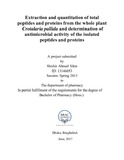| dc.contributor.advisor | Yasmin, Dr. Hasina | |
| dc.contributor.author | Sikta, Shishir Ahmed | |
| dc.date.accessioned | 2018-02-06T04:38:15Z | |
| dc.date.available | 2018-02-06T04:38:15Z | |
| dc.date.copyright | 2017 | |
| dc.date.issued | 2017-06 | |
| dc.identifier.other | ID 13146053 | |
| dc.identifier.uri | http://hdl.handle.net/10361/9392 | |
| dc.description | This project report is submitted in partial fulfilment of the requirements for the degree of Bachelor of Pharmacy, 2017. | en_US |
| dc.description | Cataloged from PDF version of project report. | |
| dc.description | Includes bibliographical references (page 56-64). | |
| dc.description.abstract | Crotalaria pallida belongs to the family ‘liguminosae’ and has been used for treating various
diseases. In traditional medicine, the plant is used to treat urinary problems and fever. In
addition, a poultice of the roots is also applied to swelling of joints and an extract of the leaves is
used to expel intestinal worms. In general, plants of liguminosae family contain peptides and
proteins to protect themselves against microbial pathogens. The objective of this study was to
extract and quantify peptides and proteins from Crotalaria pallida and investigate antimicrobial
activity of this extracted peptides and proteins. A cold extraction buffer was used for the
extraction of peptides and proteins and for quantitative determination different analytical
methods were applied such as Lowry method, fluorescence spectroscopy, UV-Vis spectroscopy
and enzymatic method. BSA was used as the standard protein. The concentrations calculated by
different methods were in close proximity (Lowry method: 217 ± 5 μg/mL; fluorescence
spectroscopy: 219 ± 3 μg/mL; UV-Vis spectroscopy: 226 ± 4 μg/mL; enzymatic method: 204 ± 3
μg\mL). The antimicrobial activity of the peptides and proteins extract was observed against two
gram positive bacterial strains, Staphylococcus aureus & Bacillus subtilis and two gram negative
bacterial strains, Escherichia coli & Vibrio cholera by disc diffusion method. Kanamycin 30,
Amoxicillin 10 and Streptomycin 10 were used as standard antibacterial agents. Kanamycin 30
and Streptomycin 10 showed inhibition against Escherichia coli only whereas Amoxicillin 10
showed inhibition against Staphylococcus aureus. No inhibition was observed in other strains of
bacteria by the standard antibacterial agents which might be due to the resistance of the strains to
the agents. However no zone of inhibition was found against the four experimental species by the
extract of peptides and proteins also. | en_US |
| dc.description.statementofresponsibility | Shishir Ahmed Sikta | |
| dc.language.iso | en | en_US |
| dc.publisher | BRAC University | en_US |
| dc.rights | BRAC University project reports are protected by copyright. They may be viewed from this source for any purpose, but reproduction or distribution in any format is prohibited without written permission. | |
| dc.subject | Crotalaria pallida | en_US |
| dc.subject | Liguminosae | en_US |
| dc.subject | Peptides | en_US |
| dc.subject | Proteins | en_US |
| dc.title | Extraction and quantitation of total peptides and proteins from the whole plant Crotalaria pallida and determination of antimicrobial activity of the isolated peptides and proteins | en_US |
| dc.type | Project report | en_US |
| dc.contributor.department | Department of Pharmacy, BRAC University | |
| dc.description.degree | B. Pharmacy | |

